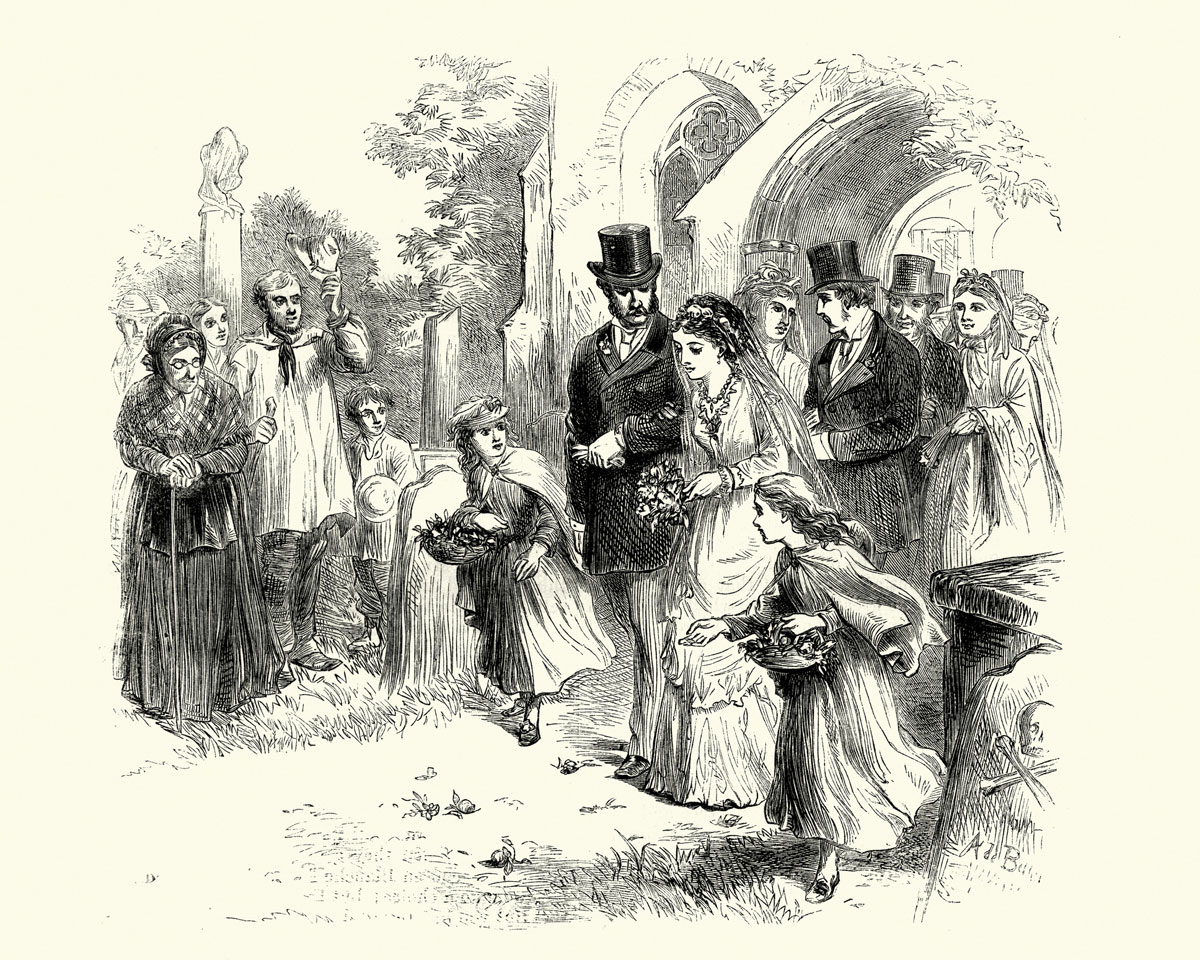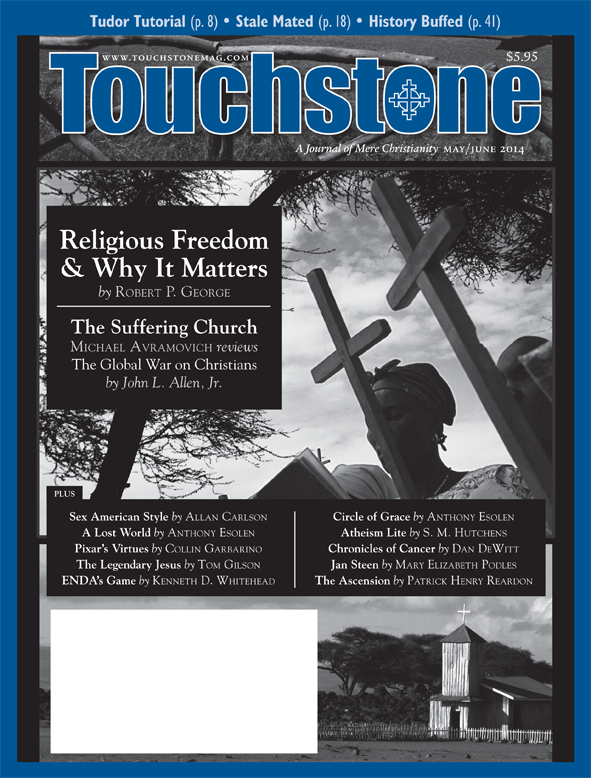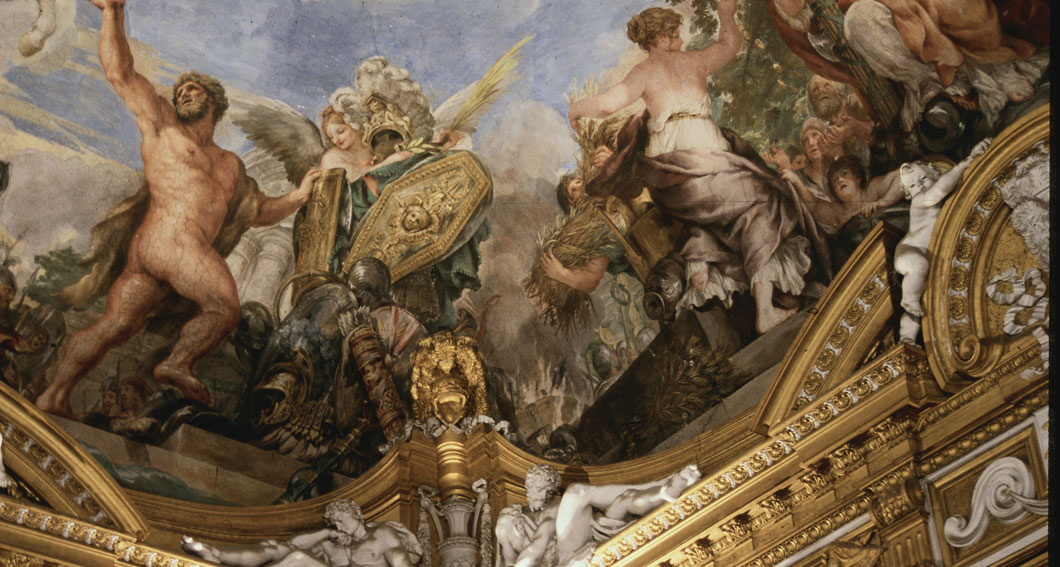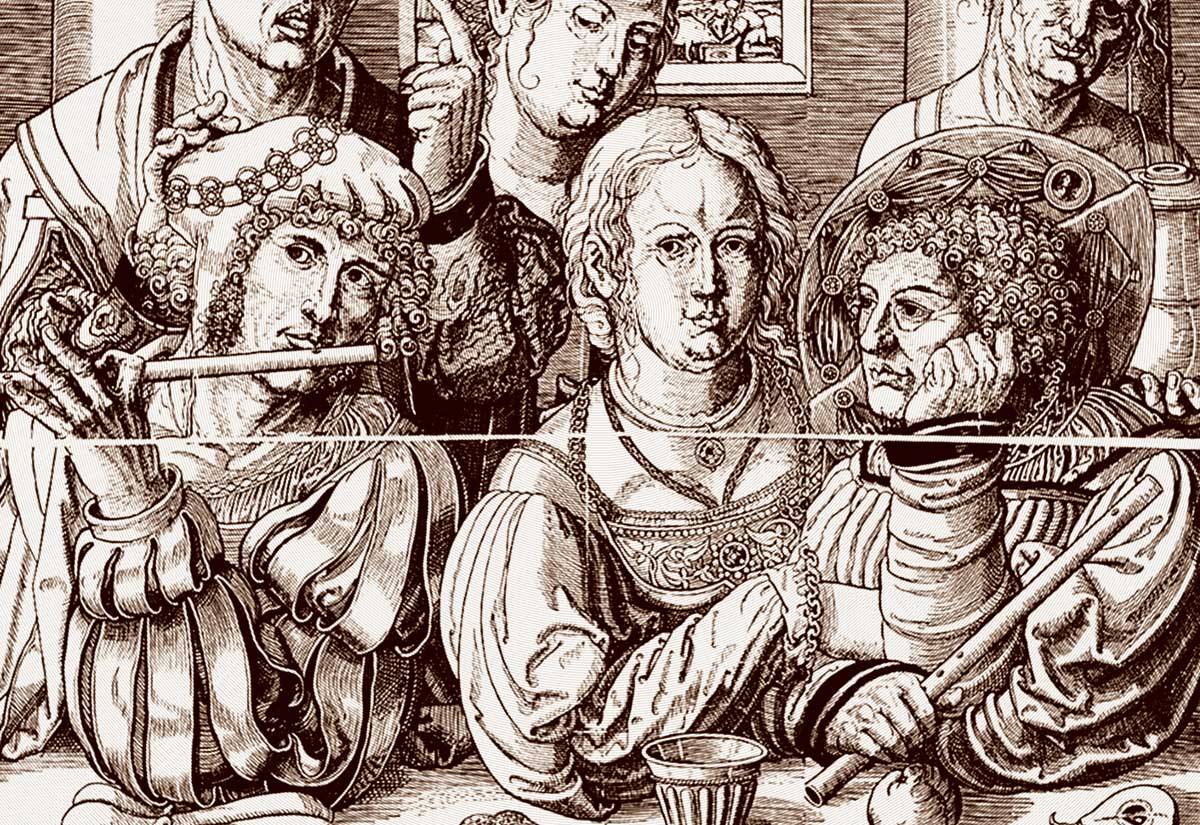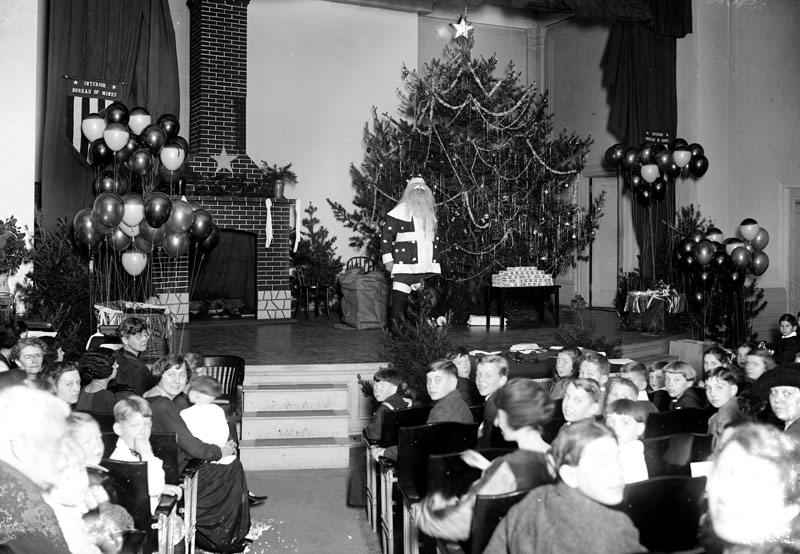Sex & the American Experience
Facts versus Stereotypes About Love & Marriage in the Land of the Free
The following is an address delivered by Dr. Carlson at Aquinas College in Grand Rapids, Michigan, on November 19, 2013, under the sponsorship of the Intercollegiate Studies Institute.
One of the assumptions of the contemporary liberal mind is that the history of Anglo-American morals has moved mainly in a linear direction: from repression to liberty. As one author of this mindset explains, the sixteenth-century English "were known throughout Europe for approaching the whole subject of sex with their well-known capacity for enduring hardship." But within Elizabethan England, the writer continues, there was a group that found even British sexual decorum "repulsive and disgusting." These Puritans "grew angrier and angrier until finally they could no longer tolerate the degenerate carrying-ons of their countrymen," and so they set sail in 1620 on the Mayflower for America.
Meanwhile, down in Colonial Virginia, the liberal story goes, the similarly twisted creators of the new Jamestown legal code declared that "No man shall commit the horrible, and detestable sins of Sodomie upon pain of death; & he or she that can be lawfully convict[ed] of Adultery shall be punished with death…and he or she, that shall commit fornication . . . for their first fault shall be whipt. . . ." The next 400 years, this contemporary liberal reports, would see a struggle to free Americans from the iron grip of Puritanism and the loathsome legal suppression of sexual joy.
Now I agree with contemporary historians of sex—a relatively new specialty in my discipline—that the story of sexuality in the American experience is vitally important and has been poorly told. I agree as well that sexuality has revolutionary potential . . . for the good. And I also agree that we Americans have been, in our better decades and eras, a sexually boisterous lot. But on other important matters, I profoundly differ.
To begin with, I view sexuality as a natural, powerful, and wonderful human impulse, but one that does require conscious channeling into culturally constructive and emotionally fulfilling paths. Vernard Eller said it well in a 1970 essay for The Christian Century:
Sex is like fire. Harnessed, disciplined, bent to human ends . . . sex is indeed a very great good, capable of serving even greater goods than the present generation has dreamed possible. However, if allowed simply to run wild, sex can be a forest fire, a most destructive—and an anti revolutionary—force.
I also underscore the profound discontinuity of sexual behavior in the American past. Careful study does not show a steady evolution from early repression toward greater freedom or license. Rather, the historical record shows an ebb and flow between periods when religious belief guided and shaped sexuality toward culture-building ends and periods when this religious influence weakened, and sexuality grew troubled or even culturally destructive. I will tell this story through six episodes from the American past.
First Episode: Puritan Marriage
Without question, Puritan New England in the seventeenth century exhibited a culture where, in two historians' words, "strong viable churches existed to buttress the authority of the family and to help supervise the rearing of children and youths." Puritan society also clearly rested on the moral indoctrination of these young through devices such as special catechisms, private religious societies, and covenant renewals, where groups of the young came together on the Sabbath to reaffirm the Christian covenants made by their parents.
And yet, these Puritans were also a surprisingly frisky and sensual bunch. A fine, and still largely unchallenged, source here is Edmund Morgan's classic study from 1944, The Puritan Family.
Morgan argues that "the Puritans were a much earthier lot than their modern critics have imagined." Consider, for example, this poem written by the Puritan goodwife Anne Bradstreet to her husband Simon, who was among the founders of the Massachusetts Bay Colony in 1630. It is entitled "A Letter to Her Husband, Absent upon Publick Employment":
I, like the earth this season, mourn in black,
My Sun is gone so far in's Zodiack,
Whom whilst I 'joy'd, nor storms, nor frosts I felt,
His warmth such frigid colds did cause to melt.
My chilled limbs now nummed lye forlorn;
Return, return sweet Sol from Capricorn;
In this dead time, alas, what can I more
Than view those fruits which through thy heat I bore.
The "fruits" referred to here are, of course, their children, the offspring of Christian marital ardor and love. That's pretty steamy, albeit completely marital.
Second Episode: The Backcountry Folk of Appalachia
During the eighteenth century, thousands of Scots and Ulstermen left the British Isles to settle on the American frontier, particularly in the hill country of the Carolinas and Virginia. David Hackett Fisher tells their remarkable story in his book, Albion's Seed.
As he shows, these backcountry Scotch-Irish had energetic sex lives. Along with Calvinism, they brought from the old country a distinctive set of sexual and marriage customs: the abduction or—more frequently in their time—the mock abduction of brides, often involving payments of a "body price" and an "honor price"; bidden marriages and bridewain; wild feasts fueled by homemade whiskey; reels and jigs; the rituals surrounding the wedding chamber; and "the constant presence of Black Betty," the whiskey bottle symbolizing the sexual side of marriage.
The Scotch-Irish also engaged in the practice of "bundling," where the young, unmarried couple spent a night alone, "bundled up" to prevent too great an intimacy, and where—if the knots or stitches failed—the now future groom would be known.
As one anonymous backcountry poem from the late eighteenth century had it:
Some maidens say, if through the nation,
Bundling should quite go out of fashion,
Courtship would lose its sweets; and they
Could have no fun till wedding day.It shant be so, they rage and storm,
And country girls in clusters swarm
And fly and buzz like angry bees
And vow they'll bundle when they please.Some mothers, too, will plead their cause,
And give their daughters great applause,
And tell them 'tis no sin nor shame,
For we, your mothers, did the same.
As a result of these customs, backcountry families were huge. As the Anglican missionary Charles Woodmason reported with disgust and only slight exaggeration: "there's not a cabin but has ten or twelve young people in it. . . . In many cabins you will see ten or fifteen children and grandchildren of one size and the mother looking as young as the daughter." This might be called sexuality with a purpose!
Third Episode: Ben Franklin
In 1755, this American polymath published an essay on "Observations concerning the Increase of Mankind, Peopling of Countries, Etc." Europe, he saw, had little surplus land and was filled with manufacturers, which suppressed marriage and fertility. But in America, "Land being thus Plenty . . . and so cheap as that a labouring Man, that understands Husbandry, can in a short Time save Money enough to purchase a Piece of new Land sufficient for a Plantation, whereon he may subsist a Family." These new American farmers were "not afraid to marry," for they could look ahead and see that their children, when grown up, could be provided for as well.
In a line that Adam Smith would more or less crib two decades later, Franklin continued: "Hence marriages in America are more general, and more generally early, than in Europe." And such marriages were fertile: eight births to each marriage in America, Franklin estimated, compared to four in old Europe. The true "Fathers of their Nation," he added, would be "the Cause of the Generation of Multitudes, by the Encouragement they afford to Marriage."
These family and fertility differences had political consequences. Edward Wigglesworth, professor of divinity at Harvard, told his fellow Americans in 1776 that regardless of the results of the emerging American rebellion, the astonishing growth in American numbers ensured that the weight of empire would shift to them by 1825. This confidence inspired by surging human numbers appears to have enabled Americans to risk open confrontation with England over constitutional and economic questions. Stated more directly, America's fecundity—its abundant fertility resting on purposeful sexuality—made possible the Revolution of 1776.
Fourth Episode: The Victorian Home
During the early decades of the nineteenth century, there were signs that America was shedding its virtues. Church membership and attendance were low and falling. Per-capita alcohol consumption soared. There were clear signs, as well, that birth control practices were growing more common in America, starting among the Quakers in Pennsylvania.
Yet, during the mid-nineteenth century, America witnessed the amazing blossoming of the Christian home in Victorian America, the theme of a solid study by historian Colleen McDannell. The Catholic version of the Victorian home, she shows, featured family oratories, paintings of the Sacred Heart, and a crucifix on the wall. These domestic articles became imbued with sacred qualities. As McDannell explains, "both the men and women of Victorian America perceived the sacrality of certain household objects. Women might have made or purchased the objects—family Bibles, wax crosses, Angelus clocks—but popular literature often mentioned the objects' emotional impact on men." The Christian home in America showed that the divine dwelt in the everyday world. The good home was evidence of divine election and personal piety.
Moreover, this image of the Christian American family took bold, if unintended, steps toward uniting Protestant and Catholic homes, and so contributed to a greater sense of unity and nationhood. Protestants and Catholics found informal agreement on a set of home virtues, symbols, and rituals. Paintings of the Madonna and Child could be found in Catholic and Protestant homes alike, as could the emergence of the mother as a kind of domestic priestess.
Fifth Episode: The Baby Boom of the Mid-Twentieth Century
The American marriage rate soared in the late 1940s and 1950s. Just as among the eighteenth-century backcountry Scotch-Irish, marriage came early and became nearly universal. And, just as in the nineteenth century, liberated sexuality was reigned in by self-control and the married state. The average age for first marriage fell to 20 for women and 22 for men, very close to the astonishing numbers found among the Carolina backwoodsmen of 1750. By the early 1960s, over 95 percent of American women had married before age 40.
And the American birthrate climbed from a total fertility rate of 2.3 children per woman in 1940 to 3.8 in 1957, an increase of 73 percent in less than two decades. Protestant Sunday schools were swarming with children again, and the greatest era of new church construction in American history commenced out in the child-rich suburbs.
The real revolution, though, was among Roman Catholics, where the fertility increase was far more rapid and complete. Indeed, one might actually see the American Baby Boom as primarily "a Catholic thing." For example, the total fertility rate for married non-Catholics was 3.15 in 1953 and 3.14 in 1963, essentially unchanged; among Catholics, however, the respective figures were 3.54 and 4.25, the latter figure 35 percent above the non-Catholic one. More telling was the return of the large Catholic family. In a survey conducted during the early 1950s, only 10 percent of Catholics under age 40 had four or more children, very close to the 9 percent found among Protestants. By the late 1950s—a mere six years later—the Protestant figure was still 9 percent, but the Catholic number of large families had more than doubled to 22 percent.
More surprisingly, this surge in Catholic fertility was most pronounced among Catholic women who had attended college, a fact that violates a presumed law of sociology—i.e., that the more education a woman has, the fewer children she has. The commitment to large families was also concentrated among younger believers. Through 1965, each new cohort of young Catholics was more pro-natalist than the group before. In addition, more frequent attendance at Mass was related to higher fertility.
Why did this happen? Part of the answer lies, I believe, with a then-unified Teaching Church which—from the pope on down—focused on the holiness of family creation. As Pope Pius XII told an audience in 1958: "Large families are most blessed by God and specially loved and prized by the church as its most precious treasures." Part of the answer also lies with the new opportunities for early marriage and family creation that came as young Catholics poured out of urban ghettoes and into new homes on spacious lots in the burgeoning suburbs—a process that Benjamin Franklin had himself anticipated 200 years before.
Sixth Episode: The 1960s
A bit of summary here. There were periods in the American past of greater regulation of sexuality (as in the seventeenth and nineteenth centuries) and less regulation (as in the eighteenth and early twentieth centuries). But for the whole sweep of American history, two things had never changed: the sex act remained normatively tied to the procreation of new life; and the normative focus of the sex act was in marriage . . .
Until the 1960s, which leads to my sixth episode, one dark and pornographic. In this decade, we do face a sweeping and destructive sexual upheaval, one focused relentlessly on severing sexuality from both babies and marriage. I want to share with you some passages from one of the more illuminating books on the question.
It is called The Rape of the A*P*E*, the letters A–P–E or the acronym APE meaning, appropriately, the American Puritan Ethic. The book, published in 1973, claims to be "the Official History of the Sex Revolution." And although not written by a credentialed historian, the claim does have a ring of truth, for the publisher is none other than Playboy Press. Moreover, in its own nihilistic way, the book is honest and accurate.
So, in brief, here's the historical account of the 1960s from The Rape of the A*P*E:
First, the challenge: "To win this Revolution, we would have to disorganize the most organized society in the world, neutralize its armed forces, profane its Great Institutions. We would have to defile the world's most antiseptic culture and corrupt the world's most respectable citizenry. We would have to turn its immutable Supreme Court around, 180 degrees."
Then, the actors: "[The Revolution] called for grown men and women, determined, dedicated and dirty-minded beyond the call of duty."
Next, the campaign: "[My generation] produced and sold rock'n'roll records with risqué lyrics; we invented the term 'wonder drug,' and hailed LSD as the true panacea, pushing it at the kids in the hallowed atmosphere of Harvard. My generation wrote and read best sellers with nothing more to recommend them than a half-dozen paragraphs of old-fashioned smut. My generation manufactured T-shirts and novelties with cute suggestive sayings and sold them to our own children. We invented or at least perfected wife swapping. We performed illegal abortions."
Then, the ultimate triumph: "On April 8, 1966, Time magazine appeared in a solid black cover. Emblazoned on it in enormous red letters were three words: IS GOD DEAD? A shocking, brain-reeling blow [to the APE]. In 1970, four years later almost to the day, Pope Paul VI declared from Castel Gondolfo, Italy: GOD IS NOT DEAD. HE IS MISSING. The APE's strongest ally, missing in action."
And finally, the consequences of the sexual revolution for America: "Everything got devalued. Not just the dollar, but everything in American life. The American flag was devalued. Marriage was devalued. Virginity. Love. God. Motherhood. Mom's Apple Pie. General Motors has less value now, and so does the Bill of Rights. . . . The quality of men available to lead was devalued. Our technology was devalued; our institutions and our customs were devalued; the worth of an individual was devalued. All the Pleasures were devalued. [Sex] too. Especially too."
So sayeth the Playboy Press.
Some Advice About Sex
So now we are in the twenty-first century; this is the United States of America; this is a college campus; and I have been invited here to speak on sex. Accordingly, before I close, I would be doing less than my duty if I failed to provide to the students here some concrete advice about sex. I turn to an impeccable source: Weekly World News, a tabloid that until recently was found at supermarket checkout counters everywhere. This was a periodical unafraid to tell the truth: for example, it reported that "60 Members of the U.S. Senate Are in Fact Space Aliens," which somehow rings true. Well, like all such truth-telling tabloids, Weekly World News also provided romantic advice. One article caught my eye a few years ago, and I would like to share it with you.
Entitled "Improve Your Sex Life Tonight—The Amish Way," the article quoted Dr. Milton Ayres of the Society for the Cross-Cultural Study of Sexuality. "The best sex," Dr. Ayres reports,
starts with getting down to the basics—and there are few societies on Earth more basic than the Amish. . . . [T]he Amish go to bed early and get up early. They have plenty of energy, alertness and enthusiasm for their sex lives. . . . Amish sex is a purer, deeper kind of sex than what we are used to. You really haven't lived 'til you've tried sex Amish style.
And Dr. Ayres also provides specific tips:
• Turn off all the lights in your house. The Amish have no electricity, which means every sexual encounter takes place by romantic candlelight.
• Wear plain, modest clothing, which covers up most of your body. All the more to intensify the feeling of discovery when . . .
• Turn off all radios and TVs. Hide any movies or mainstream newspapers or magazines—so there's no comparison between the "perfect" media fantasy people and your own romantic partner.
• Purchase some farm animals to keep around your yard. The Amish are constantly around farm animals that are reproducing. This reinforces the fact that sex is natural.
And, most important,
• Regularly read the Bible, a book which encourages a healthy sex life between husband and wife.
My friends, these are the modern secrets to sexual fulfillment. Moreover, the odd truth is that, if the American media of 1776, or even 1630, had felt a need to offer sex-advice columns, these are more or less the tips that the women and men who founded this country would have read . . . and believed.
Allan C. Carlson is the John Howard Distinguished Senior Fellow at the International Organization for the Family. His most recent book is Family Cycles: Strength, Decline & Renewal in American Domestic Life, 1630-2000 (Transaction, 2016). He and his wife have four grown children and nine grandchildren. A "cradle Lutheran," he worships in a congregation of the Lutheran Church-Missouri Synod. He is a senior editor for Touchstone.
subscription options
Order
Print/Online Subscription

Get six issues (one year) of Touchstone PLUS full online access including pdf downloads for only $39.95. That's only $3.34 per month!
Order
Online Only
Subscription

Get a one-year full-access subscription to the Touchstone online archives for only $19.95. That's only $1.66 per month!
bulk subscriptions
Order Touchstone subscriptions in bulk and save $10 per sub! Each subscription includes 6 issues of Touchstone plus full online access to touchstonemag.com—including archives, videos, and pdf downloads of recent issues for only $29.95 each! Great for churches or study groups.
Transactions will be processed on a secure server.
more on sex from the online archives

28.3—May/June 2015
Of Bicycles, Sex, & Natural Law
Describing Human Ends & Our Limitations Is Neither Futile Nor Unloving by R. V. Young
more from the online archives
calling all readers
Please Donate
"There are magazines worth reading but few worth saving . . . Touchstone is just such a magazine."
—Alice von Hildebrand
"Here we do not concede one square millimeter of territory to falsehood, folly, contemporary sentimentality, or fashion. We speak the truth, and let God be our judge. . . . Touchstone is the one committedly Christian conservative journal."
—Anthony Esolen, Touchstone senior editor





